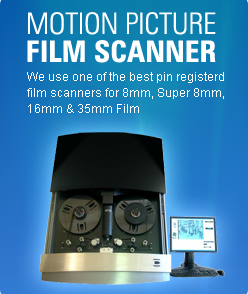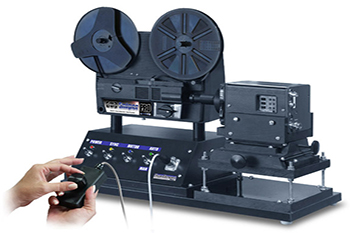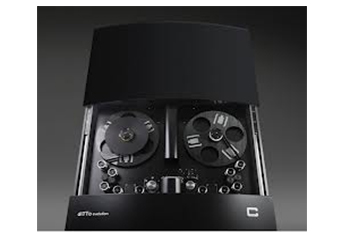
Film Conversion Equipment
Film Scanning and Film Transfer Equipment Types
The type of film scanning machine used for your 8mm, Super 8 or 16mm film conversion will have as much of an impact on the quality you receive as the resolution of the scan itself will. For example, if you wanted to digitize a photograph and tried doing it two different ways. You first put the photograph down on a table and took a picture of it using your smart phone or camera. Then you took the picture and scanned it using a flatbed scanner. If you compare the two side by side on your computer it will become really obvious that the flatbed scanner produced a digital image as good as the photograph. However, the picture you took with your phone or camera does not look close to the quality of the original photograph.
The same goes for scanning your 8mm, Super 8 or 16mm film. The real-time and frame by frame machines below are using a camcorder to take a picture of your film. The motion picture film scanner and Datacine machine are scanning the film. The results will be significantly different.
Film Conversion Equipment |
|
Real Time
|
|
Frame by Frame
|
|
Professional Film Scanners
|
|
So, at this point you’ve learned that film transfers can capture at standard definition (480 lines), high definition (1080 lines) or 2K (1556 lines). You’ve also learned about the 3 different types of film transfers being used today. In order from least to best quality we have:
Marietta Fun Facts: The National Civic League judged Marietta one of the 10 best communities in the nation as a 2006 All-America City, the oldest and most-respected community recognition award in the country. The city of Marietta, Ga., is a full-service municipality distinguished by its unique history, sense of community and modern quality of life. The city's economic development, police, fire, parks and recreation, public works, environmental services, power and water departments serve citizens and businesses. Marietta is 15 miles northwest of Atlanta and the Cobb County seat.
Georgia Fun Facts: In 1864, Union General William Tecumseh Sherman invaded Georgia, captured Atlanta and began his infamous March to the Sea,cutting a 200-mile-wide swath of fire and destruction reaching all the way to Savannah. Georgia’s landscapevaries greatly as it sweeps from the Appalachian Mountains in the northto the marshes of the Atlantic coast on the southeast tothe Okefenokee Swamp on the south. The largest of the U.S. states east of the Mississippi River and the youngest of the 13 former English colonies, Georgia was founded in 1732, at which time its boundaries were even larger—including much of the present-day states of Alabama and Mississippi.








